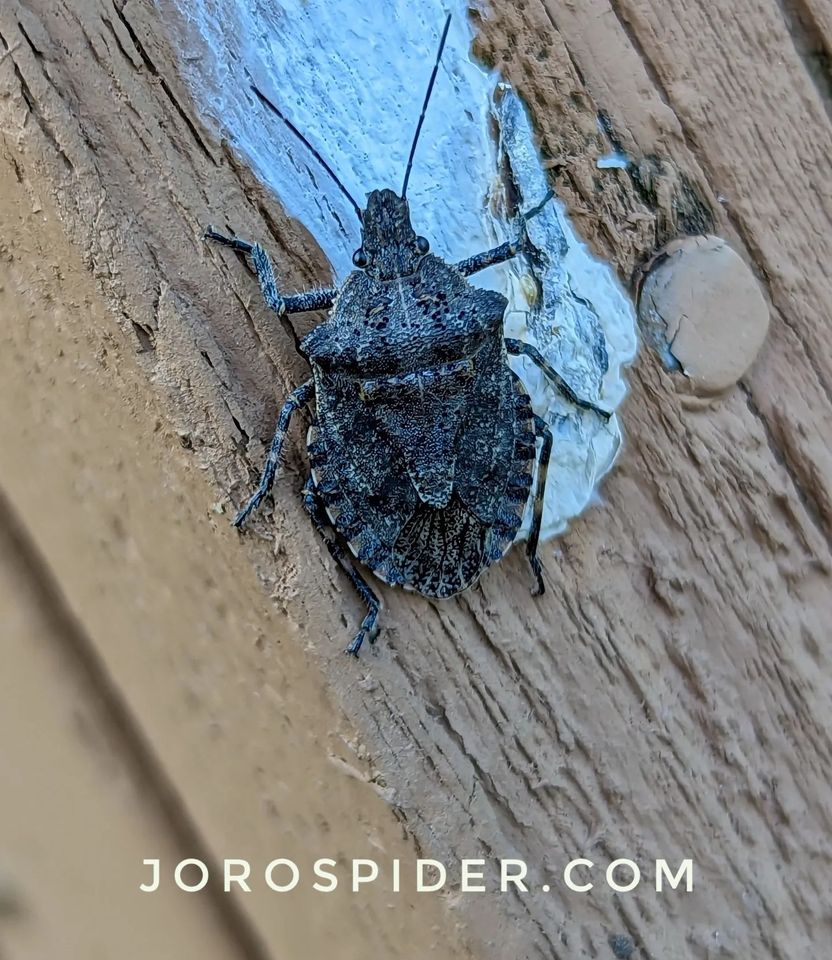What is a Brown Marmorated Stink Bug?
Why are they so bad for the environment?
What is a brown marmorated stinkbugs, why are they considered a problem, and how does this involve the Joro spider?
We get a little into the weeds below, but the short answer is that these stink bugs eat crops and garden, stink something nasty, and our favorite spider likes to eat them. To what degree the Joro spider will make an impact in the Southeast is not known as the Joro is just recently settling into its still expanding range, local life cycle, and specific diet. We’re still learning.
Predators
While it lacks significant natural predators in its introduced range, there are some organisms that have been observed to feed on it. Here are a few examples:
- Birds: Some bird species, such as sparrows, starlings, and orioles, have been known to feed on brown marmorated stinkbugs. They may consume the bugs if they encounter them while foraging for other insects or seeking food sources.
- Insects: Certain predatory insects can prey on brown marmorated stinkbugs. For instance, the wheel bug (Arilus cristatus), an assassin bug species, has been observed feeding on stinkbugs, including the brown marmorated stinkbug. Other insects like spined soldier bugs (Podisus maculiventris) and praying mantises may also eat them.
- Spiders: Some spider species (including the Joro Spider) may include brown marmorated stinkbugs in their diet. Common house spiders and orb-weaving spiders are among those that could potentially prey on these stinkbugs.
- Parasitic Wasps: Certain parasitic wasps, such as the samurai wasp (Trissolcus japonicus), have been introduced as biological control agents to manage brown marmorated stinkbug populations. These wasps lay their eggs inside the eggs of stinkbugs, eventually killing the stinkbug nymphs.
While these organisms may feed on the brown marmorated stinkbug, their presence alone is often insufficient to control its population. Efforts to manage this invasive species typically involve a combination of approaches, including biological control, insecticides, and cultural practices to limit their impact on agricultural crops and ecosystems.
Where Are They?
It is native to East Asia, particularly China, Japan, and South Korea. However, it has become an invasive species in many parts of the world, including North America and Europe.
In North America, brown marmorated stink bugs are found in the United States and Canada. They have been reported in numerous states, including but not limited to Pennsylvania, Maryland, Virginia, New York, New Jersey, Ohio, and California. We’ve seen them in Georgia. In Europe, they have been found in countries such as Italy, Switzerland, Germany, France, and Hungary.
Brown marmorated stink bugs prefer temperate climates and are often found in agricultural areas, orchards, and gardens. They are known to infest a wide range of fruit and vegetable crops, causing damage to agricultural production. Additionally, they can enter homes and other buildings in large numbers, seeking shelter during the colder months.
It’s worth noting that the distribution of brown marmorated stink bugs continues to expand, and their presence in certain regions may change over time. Therefore, it’s advisable to consult local agricultural or pest control authorities for the most up-to-date information on their distribution in your area.
Why Are They Bad?
The brown marmorated stinkbug (Halyomorpha halys) is considered a pest and is generally considered bad for several reasons:
- Agricultural Damage: Stinkbugs are known to feed on a wide range of crops, including fruits, vegetables, and ornamental plants. They pierce the plant’s tissues and suck out the sap, causing damage to the fruit or vegetable. This feeding behavior can lead to crop losses, reduced quality of produce, and economic losses for farmers.
- Invasive Species: The brown marmorated stinkbug is native to East Asia but has become an invasive species in many parts of the world, including North America and Europe. Invasive species can disrupt local ecosystems by outcompeting native species for resources and altering food chains. Their rapid spread and lack of natural predators in the new habitats contribute to their population growth and impact.
- Household Nuisance: As their name suggests, stinkbugs release a strong and unpleasant odor when disturbed or crushed. They can enter homes and buildings in large numbers, seeking shelter during the winter months. This intrusion can be a nuisance for homeowners and can require significant efforts to remove them. In other words, if you step on one, you might stink worse than the bathroom after taco Tuesday.
- Threat to Gardens and Landscapes: Stinkbugs not only affect agricultural crops but can also damage garden plants and ornamental trees. Their feeding can lead to cosmetic damage, including blemishes and discoloration on leaves, flowers, and fruit.
- Pest Management Challenges: Controlling stinkbug populations can be challenging. They have proven to be resistant to some conventional pesticides, and their ability to disperse quickly makes it difficult to contain infestations effectively. This poses a significant challenge for farmers and pest management professionals.
It’s important to note that while the brown marmorated stinkbug is considered a pest, it does not pose a direct threat to human health. Its negative impact primarily lies in the economic and ecological damage it can cause.
What Do They Eat?
- Fruits: They are known to feed on apples, peaches, pears, cherries, raspberries, grapes, and other fruits.
- Vegetables: Stink bugs may feed on crops such as tomatoes, peppers, beans, corn, cabbage, broccoli, and eggplant.
- Ornamental plants: They can also target ornamental plants like roses, azaleas, camellias, and various flowering shrubs. Your plastic plants you bought at Walmart is safe.
- Other plants: In addition to the above, stink bugs can consume a variety of wild plants, including weeds and agricultural crops like soybeans.
“We’re still learning.”


The Stuff of Nightmares or Gardens?
Maybe both. As you learn more, the nightmares will disappear.
See our sponsors: American Speechwriter and Tree Fort Books
© Copyright 2025 All Rights Reserved. JoroSpider.com
This site may contain affiliate links so I earn a commission.
Read: The Raging Giant Blue Goldfish - 22 Short Stories

